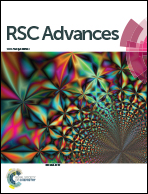A highly-deformable piezoresistive film composed of a network of carbon blacks and highly oriented lamellae of high-density polyethylene†
Abstract
The electrical resistance change of highly extensible films consisting of a network of carbon blacks in high-density polyethylene, with different regularity of stacked lamellae, is investigated. The film was fabricated by melt mixing of high-density polyethylene (HDPE) and carbon black (CB) via cast film extrusion. The morphology of particle network and regularity of stacked lamellae were affected by draw ratio during the cast film extrusion process. Testing has shown that the regularly stacked lamellar structure furnishes the film with hard elastic behavior and is conducive to the enhancement of the reversible level for the conductive film, which correlates with the piezoresistance response during the stretching and strain recovery. A rebound peak of R/R0 is observed at the beginning of each loading cycle within the relatively low deformation level and a marked growth of the amplitude of R/R0, as the number of cycle increases, is observed within the high deformation level for the film with highly regular stacked lamellae. It indicates that the regularity of stacked lamellar structure of matrix has a significant influence on the piezoresistivity of the film. The results could be utilized for the development of smart sensing and structural health monitoring of CB composite materials.


 Please wait while we load your content...
Please wait while we load your content...